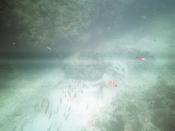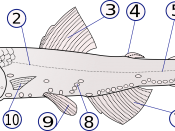Abstract: This laboratory class introduced the external anatomy of the shark under visual inspection.
Introduction: Although a few species of sharks venture into fresh water on occasion, all sharks are marine fishes. They are an easily recognizable group of fish to most people, although their closest evolutionary relatives are the very different looking skates and rays.
The fins of sharks are used for stabilizing, steering, lift and propulsion. Each of the fins are used in a different manner. There are one or two fins present along the dorsal midline called the first and second dorsal fin. These are anti-roll stabilizing fins. These two fins may, or may not have spines at their origin. When spines are present they are defensive, and may also have skin glands associated with them that produce an irritating substance. Pectoral fins originate behind the head and extend outwards. These fins are used for steering during swimming and help to provide the shark with lift.
Pelvic fins are found near the claoca and are also stabilizers. In males they have a secondary function as they are modified into copulatory organs called claspers.
Sharks possess the basic eye structure that is found in all vertebrates, but with some modification. The shark eye has a reflecting layer called a tapetum lucidum located behind the retina. Essentially the structure consists of a layer of parallel, plate-like cells filled with silver guanine crystals. The crystals reflect light that has already passed through the retina and redirects it back to restimulate the retina as it passes out through the eye. This effectively boosts the visual signal, especially in low light levels giving sharks high visual acuity.
Shark skin feels like sandpaper because it has small rough placoid scales (also known as dermal denticles). As a result, it is often dried and...


